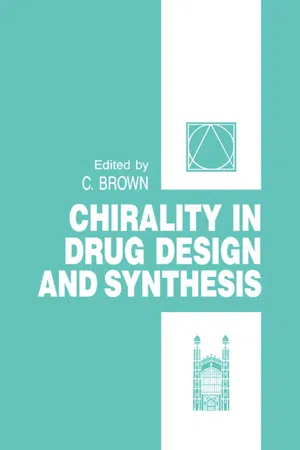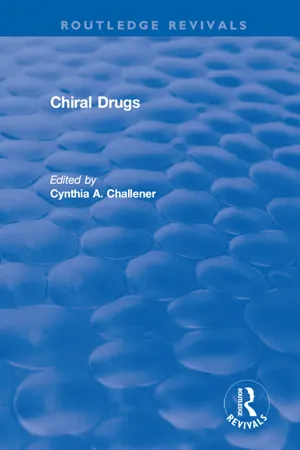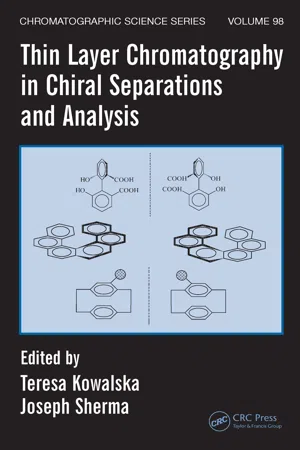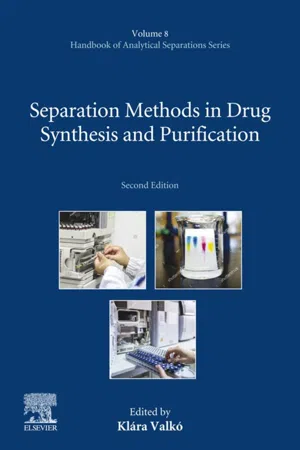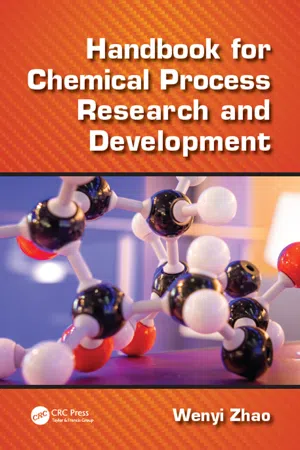Chemistry
Racemic mixture
A racemic mixture is a combination of equal amounts of two enantiomers, which are mirror-image molecules that cannot be superimposed onto each other. These enantiomers have the same physical and chemical properties but differ in their interaction with polarized light. Racemic mixtures are optically inactive due to the cancellation of the optical activity of the individual enantiomers.
Written by Perlego with AI-assistance
Related key terms
Related key terms
1 of 4
Related key terms
1 of 3
6 Key excerpts on "Racemic mixture"
- eBook - ePub
- C. Brown(Author)
- 2013(Publication Date)
- Academic Press(Publisher)
2Racemic Therapeutics—Problems all Along the Line
E.J. ARIENS, Groenewoudseweg 45, 6524 TP Nijmegen, The NetherlandsPublisher Summary
Racemic therapeutics is fixed ratio mixtures of stereoisomers, biologically to be regarded as different compounds. Usually only one of the isomers fully contributes to the therapeutic action whereas the other often is classified as a medicinal pollutant. Because of the differences in the turnover, in pharmacokinetics the proportion of the enantiomers continuously changes in plasma. The implications of the neglect of stereoselectivity at the various levels in the investigation of racemic drugs are discussed. For new chiral drugs the choice between using the racemate or the single compound is based on a critical evaluation of the chiral characteristics both therapeutically and toxicologically. This chapter states that whether violation of fundamental rights of patients as formulated in the Helsinki conventions largely depends on the ethical attitude of clinical investigators and their pharmaceutical and industrial informants.1 Introduction
The concept of stereochemistry and stereoselectivity in biological processes goes back to Pasteur and van’t Hoff–Le Bel about 100 years ago. In their memoirs (Pasteur, 1901 ) Pasteur stated:Most natural organic products, the essential products of life are asymmetric and possess such asymmetry that they are not superposable on their images … This establishes perhaps the only well marked line of dermarcation that can at present be drawn between the chemistry of dead matter and the chemistry of living matter.Chirality, stereoselectivity and stereospecific production of chemicals are characteristics of nature. Many of the xenobiotics obtained by organic synthesis are also chiral. Contrary to natural products, synthetic chiral compounds are usually obtained as isomeric mixtures such as racemates. This situation rapidly changed with the development of stereospecific catalytic methods and the application of biotechnological methods which rely on the help of enzymes as catalysts. Stereospecific syntheses and/or separation of stereoisomers were, and to a certain extent still are, laborious tasks. As a consequence, most of the synthetic chiral agents applied as drugs are marketed as Racemic mixtures or, in general, as mixtures of isomers, which illustrates that the line of demarcation between the chemistry of dead and living matter postulated by Pasteur still holds largely true for producers of drugs and pesticides (Fig. 1 ) (Ariens, 1990 - eBook - ePub
- Cynthia Challener(Author)
- 2017(Publication Date)
- Routledge(Publisher)
achiral compounds have superimposable mirror images. The word chirality is derived from the Greek word for hand and means handedness, reflecting the left and right-handedness of molecules that are chiral in nature. In fact, the left and right hands are perfect examples for demonstrating the non-superimposable property of chiral objects. The left and right hands are mirror images of each other, and no matter how the two are arranged, one cannot be placed directly over the top of the other in the exact same orientation.Stereoisomerism and enantiomersStereoisomers are compounds that have the same atoms connected in the same order but differ from each other in the way the atoms are oriented in space. Chiral molecules that are structurally different from each other only in the left and right-handedness of their orientations are called enantiomers (Figure 1.1 ). Enantiomers have the same physical properties, but behave differently under certain conditions. They react at different rates with other chiral compounds and may react at different rates in the presence of chiral catalysts and optically active solvents.Figure 1.1When polarized light is passed through a pure sample of each enantiomer, the plane of the polarized light is rotated in opposite directions in equal amounts by the two enantiomers. If rotation of the plane of the polarized light occurs, the material is considered to be optically active. An isomer that rotates light to the left is called levo- and indicated with the notation (-). An isomer that rotates light to the right is called dextro- and notated as (+).A mixture of equal amounts of enantiomers will not rotate the plane of polarized light because the opposite rotations of the individual molecules cancel each other out. This Racemic mixture is therefore optically inactive. The two enantiomers that comprise a Racemic mixture are referred to as racemates - H. John Smith, Hywel Williams(Authors)
- 2005(Publication Date)
- CRC Press(Publisher)
4.DRUG CHIRALITY AND ITS PHARMACOLOGICAL CONSEQUENCES
ANDREW J.HUTT4.1 INTRODUCTION
One in four of all therapeutic agents are marketed and administered to man as mixtures. These agents are not drug combinations in the accepted meaning of the term, i.e. two or more coformulated therapeutic agents, but combinations of isomeric substances the biological activity of which may well reside predominantly in one isomer. The majority of these mixed formulations arise due to the use of Racemic mixtures of synthetic chiral drugs and less frequently to mixtures of diastereoisomers. Over the last ten years there has been considerable interest in the area of drug chirality as a result of recent advances in the stereoselective synthesis and stereospecific analysis of chiral molecules. As a result of these advances and the realization of the significance of the pharmacodynamic and pharmacokinetic differences between the enantiomers of chiral drugs there has been increasing concern over the use of racemates, and other stereoisomeric mixtures, in therapeutics. The use of such mixtures may present problems particularly if the adverse effects, or toxicity of the drug is associated with the less active, or inactive isomer, or does not show stereoselectivity. Many authors regard racemates as “compounds which contain 50% impurity” and that their use is “polypharmacy” with the proportions of the materials being dictated by chemical rather than pharmacological or therapeutic criteria. As a result of these concerns drug stereochemistry has become an important consideration for both the pharmaceutical industry and the major drug regulatory authorities.The extent of the problem can be appreciated from the results of a survey of 1675 drugs carried out in the early 1980s. Of these agents 1200 (72%) were classified as synthetic and 475 (28%) as natural products or semisynthetic agents. Of the compounds classified as natural products or semisynthetics 469 were chiral and of these 461 (98%) were marketed as single isomers. In contrast 29% (480) of the synthetic compounds were chiral with only 3.5% (58) being available as single isomers the remainder (25%) being marketed as racemates. More recent investigations have indicated that the position regarding natural and semisynthetic agents has not changed greatly but that the proportion of synthetic agents available as single isomers had increased. From the above figures it is obvious that drug chirality is an “across-the-board” problem, mixtures of stereoisomers being found in the majority of therapeutic groups.- Teresa Kowalska, Joseph Sherma(Authors)
- 2007(Publication Date)
- CRC Press(Publisher)
17 ], who reviewed various possible modes of action of enantiomers present in drug products containing racemates.The problem of stereochemical purity of a chiral active substance acquires even more importance along with licensing of new medicinal products obtained by chemical modification of an optical isomer, which results in a racemate containing two drug substances showing distinct differences in mechanisms of action. Examples of drugs developed in such a way include α - and β -adrenergic block-ers, that is, labetalol, primidolol, or beta-adrenergic blockers, such as prizidol and sulfinalol [18 ]. Such products, despite their attractiveness, have fixed chemical composition that hinders modifications in dosage regimens, not to mention guaranteeing uniformity with respect to pharmacological profile. Further complications arise from the fact that the number of new components (drugs) in a diastereomeric mixture depends on the number of chiral centers what may lead to more isomers, as is the case for labetalol where two chiral centers give rise to four different stereoisomers.Classification of enantiomeric forms as drug “impurities” is not generally accepted. The USP does not define them as impurities in the common sense of the term but as forms of the active substance [19 ] unless individual enantiomers differ in pharmacological activity, in which case they should be treated otherwise. The FDA’s guidelines, published in 1992 [20 ], identify requirements relating to chiral compounds. If one of the enantiomers should appear more toxic, further investigations (including in vivo studies) would be required with the individual isomers. The development and use of racemic drugs is permitted in justified cases.The ICH debated issues relating to chiral impurities but no consistent guidance has been produced. Even though the problem of classification and control of enantiomeric forms as impurities has been broadly discussed, the guideline Q3A does not address this issue clearly [21- Klara Valko(Author)
- 2020(Publication Date)
- Elsevier Science(Publisher)
Increasing evidence shows the medicinal advantage of using pure enantiomers over racemates, as active drug substances have also boosted the sale of so-called single-enantiomer drugs [ 4, 10, 11 ]. Nowadays, single-enantiomer drugs represent a large part of the global pharmaceutical landscape. The percentage of single-enantiomeric drugs on the market continuously increased during the last decades, from 10% before the 1990s to about 37% in 2005 [ 12 ]. The three top-selling drugs in 2008 were single enantiomers [ 13 ]. Although there is no formal obligation to commercialize new chiral active drug products as a pure enantiomer, the flow charts in the guidelines highly encourage this choice. These requirements have transformed chiral separations into an extensively studied field in the current pharmaceutical domain. The separation of racemates, both on an analytical level for drug development and on a preparative level for drug commercialization, is essential. Although asymmetric synthesis and enantioselective crystallization allow pure enantiomers to be obtained, chromatographic separations of Racemic mixtures still remain the most cost-effective and preferred approach, especially in early drug development [ 14 – 17 ]. 9.2. Enantioseparations of racemates in liquid chromatography and sub/supercritical fluid chromatography In general, it is a very tedious task to separate two enantiomers because of their strong resemblance in stereostructure. As all physicochemical properties (with the exception of their optical activity) are identical for enantiomers, their separation can only be achieved within a chiral environment. When chiral molecules interact with chiral reagents, also called chiral selectors in separation science, the enantiomers form transient diastereomeric complexes with the chiral selectors, which have different chemical and physical properties- Wenyi Zhao(Author)
- 2016(Publication Date)
- CRC Press(Publisher)
13 StereochemistrySome enantiomeric drugs display improved pharmacological profile compared to the racemates or the enantiomeric isomers.1 For example, racemic bupivacaine hydrochloride (Marcaine) (Figure 13.1 )2 is currently used as an epidural anesthetic during labor and for ulnar nerve block for local anesthesia in minor operations. At high doses, however, it is potentially hazardous due to cardiotoxicity problems. A clinical study found that the myocardial contractility index and the stroke index were reduced by a greater degree with racemic bupivacaine than with levobupivacaine. This evidence indicates that the use of levobupivacaine is significantly safer than racemic bupivacaine due to its lower cardiotoxicity.Tramadol [2-(dimethylaminomethyl)-1-(3-methoxyphenyl)cyclohexanol] (Figure 13.2 ) is a mild, nonaddictive, centrally acting binary analgesic agent, introduced in Germany in the later 1970s by Grunenthal (Germany).3 It was approved for use in the United States in 1995 and is currently marketed as Ultram by Ortho-McNeil Pharmaceuticals, Inc. While the marketed form is the racemic hydrochloride salt of the cis-isomer, the (+)-enantiomer of the cis-isomer exhibits analgesic activity 10-fold higher than that of the (−)-enantiomer.4On average, 56% of contemporary pharmaceuticals contain one or multiple chiral centers. Generally, two approaches are now available to address absolute stereochemistry, including (1) chemocatalytic/biocatalytic asymmetric synthesis and (2) chiral resolution and chromatographic separation. Despite tremendous development in recent years, asymmetric synthesis accounts for only 20% of the stereogenic centers generated during the synthesis of drug molecules.5 The resolution methods remain the major tool to prepare chiral drug molecules in the pharmaceutical industry.13.1 ASYMMETRIC SYNTHESISIn the past two decades, asymmetric synthesis has been one of the most interesting areas in synthetic chemistry. Utilization of asymmetric catalysis in industrial processes can provide superior yield and reduce the waste streams during the manufacture of pharmaceutical products. The asymmetric reaction may be characterized into three categories: (a) the use of chiral catalyst (asymmetric catalysis), (b) the use of chiral substrates or reagents (chiral pool synthesis), and (c) the use of chiral auxiliaries.
Index pages curate the most relevant extracts from our library of academic textbooks. They’ve been created using an in-house natural language model (NLM), each adding context and meaning to key research topics.
Explore more topic indexes
Explore more topic indexes
1 of 6
Explore more topic indexes
1 of 4
